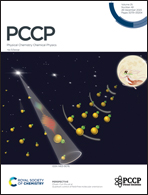The electrocatalytic N2 reduction activity of core–shell iron nanoalloy catalysts: a density functional theory (DFT) study†
Abstract
A molecular level understanding of the property evolution in binary nanoalloy catalysts is crucial for designing novel electrocatalysts for ammonia synthesis. In this regard, designing core–shell catalyst structures has been a versatile approach to achieve the product selectivity. Herein, we investigated the activity evolution of Fe-based core–shell (M15@Fe50) (M = Co, Ni, or Cu) clusters for the nitrogen reduction reaction (NRR). Nitrogen reduction following the associative mechanistic pathway is significantly activated over the Cu15@Fe50 cluster. The d-band center from the electronic structure analysis is found to be upshifted, justifying the activity towards the NRR. The reduction reaction occurs via the surface restructuring of the catalyst, in which the *NH2 formation is found to be the lowest endergonic potential determining step compared to pristine Fe(110). Based on this, the high NRR activity of the Cu15@Fe50 cluster has been proposed, which, we envision, will provide useful insights into the position and compositional effects of core–shell structures for the discovery of efficient NRR electrocatalysts.



 Please wait while we load your content...
Please wait while we load your content...